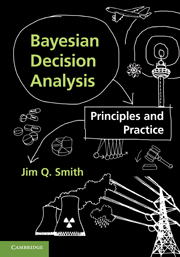10 - Conclusions
from Part II - Multidimensional Decision Modelling
Published online by Cambridge University Press: 05 June 2012
Summary
A summary of what has been demonstrated above
The results and analyses in this book have demonstrated the following points:
A Bayesian decision analysis delivers a subjective but defensible representation of a problem that guides wise decision making, and provides a compelling supporting narrative for why the chosen action was taken. By crystallising the reasons behind a chosen action it can be used as a platform for new creative innovative thinking about the problem at hand and so is always open to re-evaluation and reformulation.
A DM can use the framework above to address not only simple decision problems but also highly structured, high-dimensional multifaceted problems.
The DM will usually need guidance to identify both the structure of her utility function and an appropriate credence decomposition over the features of the problem she believes might influence her decision. We have seen that it is extremely helpful if these elicitation processes are supported by graphs. Detailed discussions of several of these have been given above but there are many more. Graphs are important because they can not only describe evocatively consensual thinking about underlying processes but also provide a conduit into faithful and computationally feasible probabilistic models.
The quantification of a decision model's utility functions and probabilities will usually be the most contentious and most difficult features to elicit faithfully. However if the underlying credence decomposition and the structure of the utility function have been faithfully elicited then analyses are usually surprisingly robust to moderate mis-specifaction of these functions.
[…]
- Type
- Chapter
- Information
- Bayesian Decision AnalysisPrinciples and Practice, pp. 318 - 321Publisher: Cambridge University PressPrint publication year: 2010

